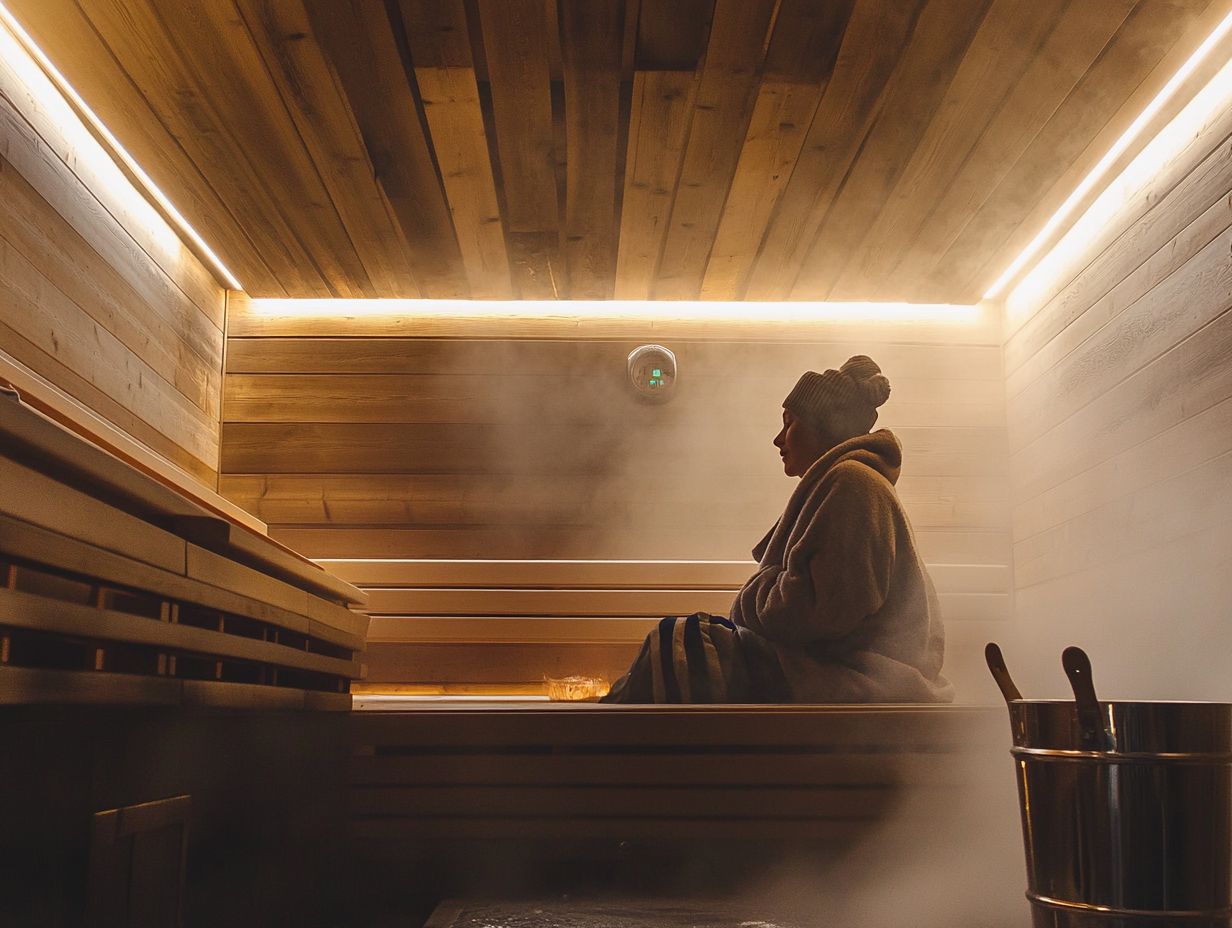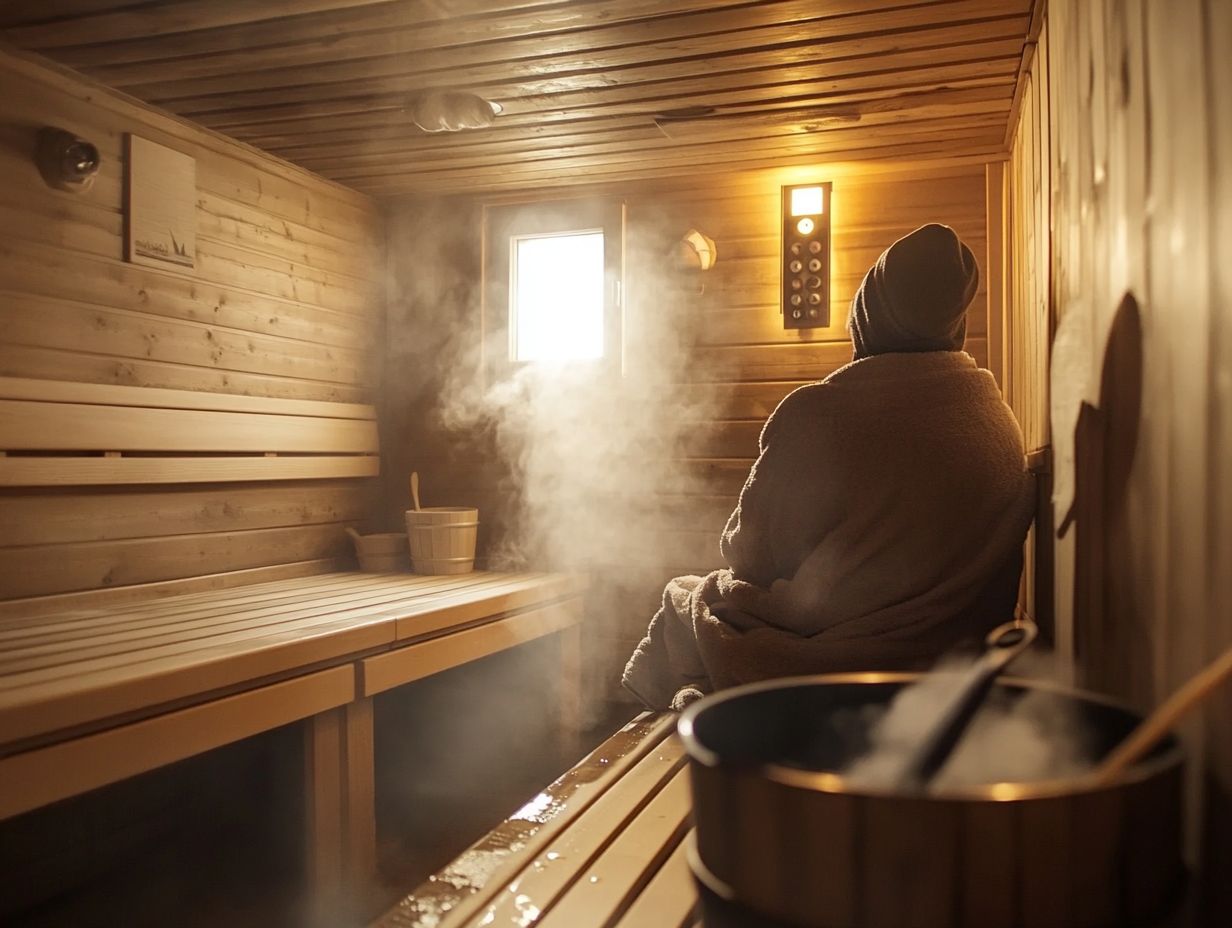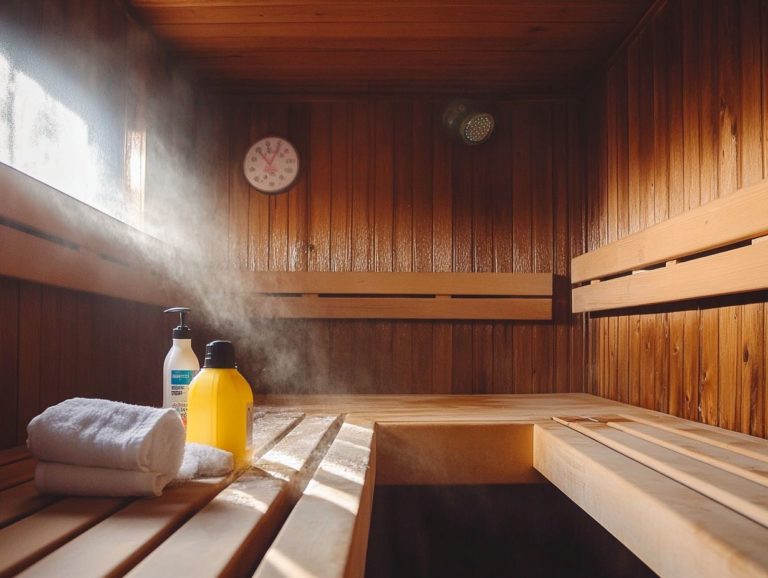Sauna Safety: Personal Experiences and Lessons
Saunas present a distinctive fusion of relaxation and potential health benefits, yet they also carry their own set of considerations.
This article delves into what a sauna truly is, sharing insights that illuminate both the positive impacts on health and well-being as well as the potential risks to be mindful of.
You ll find essential tips for safe sauna use, enriched by lessons from real-life incidents, and key takeaways designed to ensure your sauna experience is both enjoyable and safe.
Contents
- Key Takeaways:
- Discover the Amazing World of Saunas!
- Personal Experiences with Sauna Use
- Potential Risks and Safety Concerns
- Tips for Safe Sauna Use
- Precautions to Take Before and During Sauna Sessions
- Lessons Learned from Sauna Accidents
- Real-life Examples and What We Can Learn from Them
- Frequently Asked Questions
- What are some common safety concerns when using a sauna?
- Can anyone use a sauna, or are there certain precautions to take?
- What are some signs that the sauna may be too hot?
- Are there any safety tips for using a sauna with others?
- Is it safe to use a sauna after a workout?
- What precautions should I take when using a sauna at a public facility?
Key Takeaways:

- Stay safe during sauna sessions by staying hydrated and avoiding alcohol.
- Learn from real incidents to prevent accidents.
- Being aware of risks helps you enjoy saunas safely.
Discover the Amazing World of Saunas!
A sauna offers a traditional way of relaxing in hot steam or dry heat, typically maintained between 150 F to 195 F. Whether you prefer the dry sauna or the steam bath approach, this age-old practice, dating back to 2000 BC, serves as a cultural cornerstone that promotes relaxation, wellness, and rejuvenation for both body and mind.
Regular sauna sessions can enhance your overall health by improving circulation, getting rid of harmful substances in the body, and boosting mental clarity. This makes it an essential practice for stress relief and self-care.
Originally rooted in the ancient tradition of communal bathing, saunas have transformed into much more than just a wellness ritual. They play a vital role in Finnish society, representing a space for social interaction and intimate gatherings.
In a traditional dry sauna, heat comes from heated rocks, radiating warmth throughout the space, while the steam sauna introduces water droplets to create a humid atmosphere. Each type provides its own therapeutic benefits, such as alleviating muscle tension and promoting skin health.
In Finnish culture, the sauna is celebrated not only for its health-boosting properties but also as a sanctuary for contemplation and mindfulness. This illustrates the profound connection between physical wellness and spiritual peace that you can tap into during your sauna experience.
Personal Experiences with Sauna Use
Your personal experiences with saunas can be life-changing! Integrating this soothing therapy into your daily routine can elevate your overall wellness and mindfulness practices.
Whether you engage in a social experience within the vibrant LGBTQ+ community or carve out a serene moment for self-reflection, saunas become a communal sanctuary that nurtures relaxation and rejuvenation.
Positive Effects on Health and Well-being
Using a sauna regularly opens the door to remarkable health benefits, such as improved circulation, enhanced detoxification, and significant stress relief. Research from the Medical Journal of Austria and Harvard Health Publishing shows that consistent sauna sessions play a vital role in mental health recovery, reduce anxiety, and elevate sleep quality.
Regular sauna use may boost cardiovascular health by lowering blood pressure and increasing heart rate, effectively mimicking the benefits of moderate exercise. This enhances endurance and promotes overall heart function.
Detoxification through sweating helps your body eliminate harmful toxins, leading to a clearer complexion and more vibrant skin. The soothing atmosphere of a sauna creates a sanctuary for relaxation, enabling you to unwind and recharge an essential practice for managing daily life stresses.
These holistic advantages highlight why incorporating sauna sessions into your routine is a proactive strategy for maintaining a healthy lifestyle.
Potential Risks and Safety Concerns

While saunas offer many benefits, it s crucial to be aware of potential risks and safety concerns. Excessive heat can lead to dehydration, dizziness, or even fainting. Knowing your limits, especially regarding temperature control, is vital.
This knowledge is particularly important if you have certain pre-existing health conditions or take medications that increase heat sensitivity. Remember to stay hydrated before, during, and after using the sauna to replenish lost fluids and support your well-being. Additionally, understanding sauna safety can further enhance your experience and well-being.
Moderation is key. Limit each session to about 15-20 minutes to avoid negative effects. Don’t forget to take a cold shower afterward; it helps with temperature regulation, invigorates your body, and boosts circulation, enhancing the health benefits of sauna therapy. For more insights, check out sauna safety: personal stories and experiences.
Tips for Safe Sauna Use
To maximize the benefits of sauna use while minimizing risks, follow specific safety tips and precautions. These guidelines guarantee a positive experience.
By familiarizing yourself with best practices for sauna sessions, you can elevate your relaxation and wellness routine into a truly enriching experience.
Precautions to Take Before and During Sauna Sessions
Before and during your sauna sessions, taking precautions is vital for a safe and comfortable experience. Consider factors like previous health conditions, your hydration levels, and how long you plan to stay in the heat.
Consulting a healthcare professional is advisable, especially if you have medical conditions such as high blood pressure or heart-related problems. Stay hydrated before, during, and after your session, as the heat can lead to significant fluid loss. For more information, refer to sauna safety: promoting safe practices.
Know when to exit the sauna. If you feel lightheaded, dizzy, or uncomfortable, leave immediately. Listening to your body can help prevent negative effects and enhance your sauna experience. For more information on staying safe, check out sauna safety: understanding risk factors.
Lessons Learned from Sauna Accidents
Learning from sauna accidents provides invaluable insights into safe usage and preventing future incidents. By examining real-life cases, you can appreciate the importance of following safety guidelines and recognizing your personal limits.
Real-life Examples and What We Can Learn from Them

Examples of sauna accidents serve as reminders of the importance of safety and increased awareness among users. Reflecting on these cases can uncover valuable lessons for safer sauna practices and improved well-being.
For instance, one incident involved friends who underestimated the risks of dehydration and heat stress during a long sauna session. When one person felt severe dizziness, the others quickly recognized the signs and sought immediate medical attention. This experience sparked important conversations about hydration and self-awareness in the group, illustrating how communities can discuss sauna safety.
Reports of burns from poorly placed rocks or malfunctioning heaters highlight the need for understanding sauna equipment. This knowledge encourages collective responsibility, promoting sauna safety for everyone.
Key Takeaways and Final Thoughts
When you explore sauna use, focus on the benefits, risks, and essential safety practices. Understanding these elements will help you dive into this ancient tradition and unlock its powerful wellness benefits.
Hydration is crucial when using a sauna. Limit your time in the sauna to minimize risks associated with excessive heat exposure.
Incorporating these guidelines not only enhances your enjoyment of a sauna session but also maximizes its therapeutic effects, such as improved circulation, detoxification, and relaxation. If you’re unfamiliar with detoxification, it refers to the process of removing toxins from the body.
Taking your personal health conditions into account and consulting with a healthcare professional can help guarantee that this rejuvenating experience remains safe and beneficial. By prioritizing sauna safety practices, you can harness the full spectrum of benefits, promoting health and well-being for both body and mind in your daily routine.
Frequently Asked Questions
What are some common safety concerns when using a sauna?
Common safety concerns include overheating, dehydration, and slipping on a wet sauna floor. Stay hydrated and limit your time in the sauna to avoid these risks.
Can anyone use a sauna, or are there certain precautions to take?

While most people can enjoy saunas, certain precautions are necessary. Pregnant women, individuals with heart conditions, and those who have recently consumed alcohol should consult with a doctor before using a sauna.
Follow the recommended time limits and ensure you stay hydrated.
What are some signs that the sauna may be too hot?
If the heat in the sauna makes you feel faint or dizzy, it may be too hot for you. Symptoms can include a rapid heart rate, excessive sweating, or difficulty breathing.
If you experience any of these symptoms, leave the sauna and cool down immediately.
Are there any safety tips for using a sauna with others?
When using a sauna with others, communicate and respect each other’s needs and limits. Ensure everyone is aware of the recommended time limits and take turns using the sauna.
Keep the sauna clean and dry to prevent slipping hazards.
Is it safe to use a sauna after a workout?
Using a sauna after a workout can be beneficial, helping to relax muscles and aid in recovery. However, avoid overdoing it and remember to rehydrate properly.
It’s recommended to wait at least 10-15 minutes after your workout to allow your body to cool down before entering the sauna.
What precautions should I take when using a sauna at a public facility?
When using a sauna at a public facility, follow all posted safety guidelines and ask staff for any additional tips. Bring your own towel to sit on and use as a barrier between your skin and the sauna bench.
Additionally, be aware of your surroundings and exercise caution with others using the sauna.






